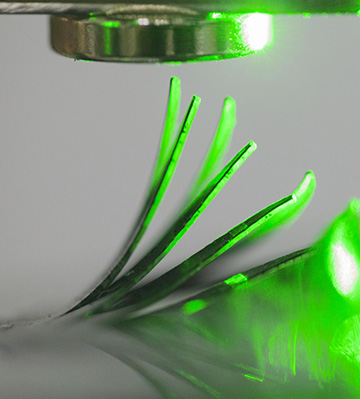
A film deflects from a magnetic field when exposed to light. [Image: SilkLab / Tufts University]
A team of U.S. researchers led by OSA Fellow Fiorenzo Omenetto of Tufts University have used elastomers and biopolymers doped with ferromagnetic powder to create a potential platform for light-controlled actuation and interfaces (Proc. Natl. Acad. Sci. U.S.A., doi: 10.1073/pnas.1805832115). The optomechanical platform uses the principle of the Curie temperature—the temperature above which a material loses its magnetic properties—to induce movement, similar to the way that leaves and flowers bend themselves toward the sun, in response to light and heat.
The researchers demonstrated films, sponges and hydrogels made from their elastomeric composites that can grip and release, bend back and forth, propel and rotate in response to being heated by a laser while in a controlled magnetic field. By combining these movements, says Omenetto, he and his team could potentially create formats with more complex motions, such as crawling, walking or swimming. And these complex formats could potentially be coupled with “flexible electronic or soft robotic platforms and new modes of wireless, untethered dynamic interfaces.”
Light-actuated magnetic composites
Optomechanical methods currently in use include actuation on a molecular scale with liquid-crystal systems and on a device scale with microelectromechanical systems. Now, Omenetto and his colleagues propose a new macro-scale optomechanics platform using flexible composites containing low-Curie-temperature magnetic materials that move or change shape in a magnetic field when they are heated with a laser or sunlight, and return to their original position or shape when they cool (in other words, the materials’ magnetization decreases and then rebounds, respectively).
The new elastomeric materials consist of transparent, flexible and magnetically inert polydimethylsoloxane (PDMS) or silk fibroin (a biomaterial Omenetto’s group is well known for working with), doped with chromium dioxide (CrO2) powder. CrO2 is ferromagnetic and has a low Curie point of 118 °C, making it easy to change its magnetic properties at temperatures close to room temperature.
When the elastomeric composite is placed in a magnetic field, it bends or pulls toward the magnet and achieves an equilibrium state as the magnetic force matches its elastic force. The equilibrium state is disturbed when the material is exposed to a laser or sunlight. The material converts photonic energy into thermal energy, and as the material’s temperature rises, its magnetization decreases. This results in actuation in the form of movement or distortion, depending on the shape of the material. As the material cools, it returns to its original equilibrium state.
A spinning engine and a blooming flower
To demonstrate the platform’s ability to achieve complex actuation patterns beyond bending and twisting, Omenetto and his colleagues built a Curie engine from a 3-cm ring of their light-actuated PDMS film mounted on a needle support. They placed the structure close to a permanent magnet. When a laser hit a specific spot on the ring, that spot demagnetized while the rest of the ring remained magnetized. This created an unbalanced vertical net force, which caused the ring to turn. As the ring turned, a new spot was hit by the laser and the previous spot moved away, cooled, and its magnetic properties returned. The Curie engine achieved a speed of two rotations per minute:
To demonstrate the platform’s ability to locally control and selectively actuate portions of the material, the researchers created a flower shape made from light-actuated PDMS film. The flower was mounted on a slowly rotating post in the presence of a permanent magnet. As each of the six petals passed in front of a laser beam, they bent toward the laser and away from the magnet, giving the impression of the flower petals individually blooming:
Other demonstrations included using a ferromagnetic sponge format that, when demagnetized by sunlight, moved a levitated permanent magnet; and a claw-like structure attached to the end of an optical fiber that could tighten its “fingers” around a small object and lift it when exposed to a laser beam and release the object when the laser was turned off and the fingers remagnetized.
